

Mas Erick-津波工学研究室(東北大学大学院工学研究科)- Guide%20du%20regime%20auto%20entrepreneur%202012. L'expertise profane dans la lutte contre le sida. La première des Journées scientifiques 2010 du réseau des jeunes chercheurs en sciences sociales et VIH/sida avait pour thème «Etat des lieux, enjeux et limites de l'expertise profane dans la lutte contre le sida».
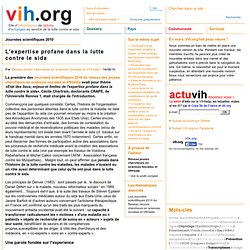
Cécile Chartrain, doctorante CRAPE, de l'Université Rennes 1, était chargée de l'introduction. Commençons par quelques constats: Certes, l'histoire de l'organisation collective des personnes atteintes dans la lutte contre la maladie ne date pas de l'apparition du sida (on pourrait renvoyer au moins à la création des Alcooliques Anonymes dès 1935 aux Etats Unis).
Certes encore, au-delà des démarches d'entraide, des formes de contestation du pouvoir médical et de revendications politiques des malades (et/ou de leurs représentants) ont existé bien avant l'arrivée le sida (cf. travaux sur le handicap mental dans les années 1970 notamment). Une parole fondée sur l'experience Les objectifs de la journée En organisant cette journée, nos objectifs étaient donc :
Les idées de cadeaux de Noel à offrir à votre Psy! Www.brad.ac.uk/acad/management/external/pdf/workingpapers/2008/Booklet_08-10.pdf. Taiwan Panorama- Everyday we move in different spheres, working, playing, traveling and resting in many different spaces.
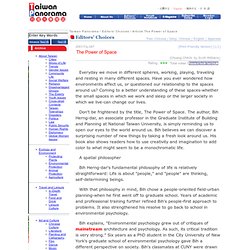
Have you ever wondered how environments affect us, or questioned our relationship to the spaces around us? Coming to a better understanding of these spaces-whether the small spaces in which we work and sleep or the larger society in which we live-can change our lives. Don't be frightened by the title, The Power of Space. The author, Bih Herng-dar, an associate professor in the Graduate Institute of Building and Planning at National Taiwan University, is simply reminding us to open our eyes to the world around us.
Pdfs/ecological-disaster-as-contextual-transformation.pdf. The International Journal of Environmental, Cultural, Economic and Social Sustainability » Community Sustainability and Natural Hazard Resilience: All-Hazard and Cross-Cultural Issues in Disaster Resilience. By Douglas Paton.
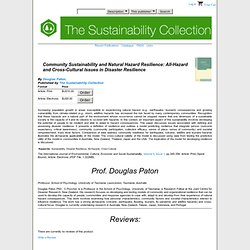
Published by The Sustainability Collection Increasing population growth in areas susceptible to experiencing natural hazard (e.g., earthquake, tsunami) consequences and growing vulnerability from climate-related (e.g., storm, wildfire) hazards has increased the risk faced by many contemporary communities. Recognition that these hazards are a natural part of the environment whose occurrence cannot be stopped means that one dimension of a sustainable society is the capacity of it and its citizens to co-exist with hazards.
Place Attachment Inventory (PAI) Steven Semken Arizona State University This is an experimental psychometric instrument that measures an individual's attachment to specific or general places, by means of two dimensions: self-identification with a place, and the capacity of the place to support a person's activities or goals.

The Psychological Hurdle to Earthquake Preparedness. The final death toll from the earthquake and resulting tsunami in Japan is now expected to exceed 18,000 . While that number paints a far graver picture than the initial, much lower estimates, many believe that the human fallout from a magnitude 9.0 quake would have been worse if it wasn’t for the country’s strict building codes . In that sense, Japan’s path towards resiliency should be a lesson to other nations threatened by seismic activity. Either modernize and fortify your construction and infrastructure or jeopardize the lives of your citizens when the next major earthquake hits.
Unfortunately, improved building standards are not the only impediment to better preparedness. A new study from a University College London researcher Helene Joffe has shown that there are some significant psychological hurdles as well — and the underlying rationale may vary from culture to culture. Other survey participants came from Turkey, another nation with high seismic risks. Www.geo.mtu.edu/~raman/MiTEP-ESS-1/semken08_sop.pdf. Www.corstone.org/html/downloads/Implications of Resilience Concepts.pdf. The psychology of disaster. Fortunately, for most of us, we learn about disasters through movies or books and not direct experience.

These renditions are dramatic snapshots of lives, events, and heroism, but rarely do they show us the long-term impact of disasters on wildlife, psychology, culture, environment or finance. The Psycho-Spatial Dimension of Global Environmental Problems (David Uzzell) Importantly, to do something about them is that most global environmental problemssuch as the destruction of the ozone layer and global warming are regarded asimpersonal, indirect and long-term.
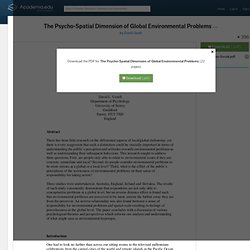
Vining and Ebro (1990) assert that it is onlyworthwhile investigating local environmental knowledge as people display difficultiesin understanding and assimilating complex, distant problems. Zube (1991) argues forthe importance of studying how people perceive and interact with the environment at alocal level because it is at this level people function and exist in most meaningful ways.It would seem then that we are faced with a contradiction. On the one hand thecommunication and presentation of environmental issues primarily raises awareness ata global level. On the other hand, many authors argue that the communication of information about environmental problems should be at the local level as it is only atthis level that it is meaningful to the public. Et al. Www.psy.pku.edu.cn/Upload/pubs/2012031700007.pdf. Www.nat-hazards-earth-syst-sci.net/10/1663/2010/nhess-10-1663-2010.pdf. Living Through and Surviving Traumatic Events.
Kirsti A.
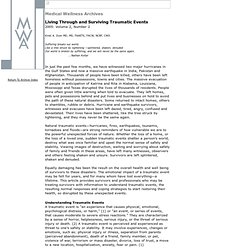
Dyer MD, MS, FAAETS, FACW, NCBF, CWS Suffering breaks our world. Like a tree struck by lightening —splintered, shaken, denuded Our world is broken by suffering, and we will never be the same again. ...Nathan Kollar. Environmental psychology: behaviour and experience in context - Tony Cassidy. Environment and the Psychology of Behavior. Environmental psychology: An endangered species? At a point in time when the APS is putting the environment on the priority action agenda, it is worth asking what has happened to the field of environmental psychology in Australian psychology education and training.
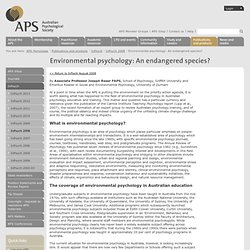
This matter and question has a particular currency and relevance given the publication of the Carrick Institute Teaching Psychology report (Lipp et al., 2007), the recent formation of an expert group to review Australian psychology training, and of course, the political saliency and indeed critical urgency of the unfolding climate change challenge and its multiple and far reaching impacts.